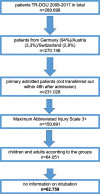Is prehospital intubation of severely injured children in accordance with guidelines?
- PMID: 36474145
- PMCID: PMC9724279
- DOI: 10.1186/s12873-022-00750-1
Is prehospital intubation of severely injured children in accordance with guidelines?
Abstract
Background: The current German S3 guideline for polytrauma lists five criteria for prehospital intubation: apnea, severe traumatic brain injury (GCS ≤8), severe chest trauma with respiratory failure, hypoxia, and persistent hemodynamic instability. These guideline criteria, used in adults in daily practice, have not been previously studied in a collection of severely injured children. The aim of this study was to assess the extent to which the criteria are implemented in clinical practice using a multivariate risk analysis of severely injured children.
Methods: Data of 289,698 patients from the TraumaRegister DGU® were analyzed. Children meeting the following criteria were included: Maximum Abbreviated Injury Scale 3+, primary admission, German-speaking countries, years 2008-2017, and declaration of intubation. Since children show age-dependent deviating physiology, four age groups were defined (years old: 0-2; 3-6; 7-11; 12-15). An adult collective served as a control group (age: 20-50). After a descriptive analysis in the first step, factors leading to prehospital intubation in severely injured children were analyzed with a multivariate regression analysis.
Results: A total of 4489 children met the inclusion criteria. In this cohort, young children up to 2 years old had the significantly highest injury severity (Injury Severity Score: 21; p ≤ 0.001). Falls from both high (> 3 m) and low heights (< 3 m) were more common in children than in adults. The same finding applied to the occurrence of severe traumatic brain injury. When at least one intubation criterion was formally present, the group up to 6 years old was least likely to actually be intubated (61.4%; p ≤ 0.001). Multivariate regression analysis showed that Glasgow Coma Scale score ≤ 8 in particular had the greatest influence on intubation (odds ratio: 26.9; p ≤ 0.001).
Conclusions: The data presented here show for the first time that the existing criteria in the guideline for prehospital intubation are applied in clinical practice (approximately 70% of cases), compared to adults, in the vast majority of injured children. Although severely injured children still represent a minority of all injured patients, future guidelines should focus more on them and address them in a specialized manner.
Keywords: Multivariate regression analysis; Outcome; Prehospital intubation severely injured children; Trauma registry.
© 2022. The Author(s).
Conflict of interest statement
The authors declare that there are no competing interests.
Figures




Similar articles
-
Enhanced prehospital volume therapy does not lead to improved outcomes in severely injured patients with severe traumatic brain injury.BMC Emerg Med. 2019 Jan 23;19(1):13. doi: 10.1186/s12873-019-0221-x. BMC Emerg Med. 2019. PMID: 30674281 Free PMC article.
-
Observed versus expected mortality in pediatric patients intubated in the field with Glasgow Coma Scale scores < 9.Eur J Trauma Emerg Surg. 2019 Oct;45(5):769-776. doi: 10.1007/s00068-018-01065-2. Epub 2019 Jan 10. Eur J Trauma Emerg Surg. 2019. PMID: 30631886
-
Is Prehospital Time Important for the Treatment of Severely Injured Patients? A Matched-Triplet Analysis of 13,851 Patients from the TraumaRegister DGU®.Biomed Res Int. 2019 Jun 20;2019:5936345. doi: 10.1155/2019/5936345. eCollection 2019. Biomed Res Int. 2019. PMID: 31321238 Free PMC article.
-
Severely injured patients: modern management strategies.EFORT Open Rev. 2023 May 9;8(5):382-396. doi: 10.1530/EOR-23-0053. EFORT Open Rev. 2023. PMID: 37158332 Free PMC article. Review.
-
[The chapters "Stop the bleed-prehospital" and "Coagulation management and volume therapy (emergency departement)" in the new S3 guideline "Polytrauma/severe injury treatment"].Notf Rett Med. 2023;26(4):259-268. doi: 10.1007/s10049-023-01147-8. Epub 2023 Apr 20. Notf Rett Med. 2023. PMID: 37261335 Free PMC article. Review. German.
Cited by
-
Pediatric intensive care unit admissions network-rationale, framework and method of operation of a nationwide collaborative pediatric intensive care research network in Germany.Front Pediatr. 2024 Jan 10;11:1254935. doi: 10.3389/fped.2023.1254935. eCollection 2023. Front Pediatr. 2024. PMID: 38269291 Free PMC article.
References
-
- Allgemeine Jahresberichte des TraumaRegister DGU® seit dem Jahr 2000. Jahresbericht 2021. http://www.traumaregister-dgu.de/de/service/downloads.html.
MeSH terms
LinkOut - more resources
Full Text Sources
Medical
Miscellaneous

